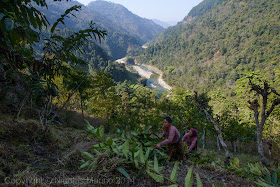Leaving the Himalayas for the lowlands of the Terai was the beginning of the immersion in the Nepalese rural life. Away from the hordes of tourists that come and go to the high Himalayas, Pokhara, Kathmandu and the eastern Terai, you have this small country pretty much for yourself. Traveling through simple villages of friendly and modest people, not obsessed with the money that supposedly all foreigners have was a true relief.
Leaving the Himalaya
The Siddhartha highway connecting Pokhara with the dusty town of Butwal, is a winding corridor between narrow canyons, terraced valleys and traditional villages. The traffic we had experienced between Kathmandu and Pokhara was reduced by at least 90% and there were several stretches of absolute peace. However, in this lower Himalayan range there is an exceptional climate, thus rural life abounds. We are in February and it's winter, but daytime temperatures reach a balmy 24 C. The valleys are fertile and filled with terraced hillsides full of yellow flowers. Off the road one can see the female villagers as little dots moving up and down from terrace to terrace collecting plants and flowers.
It's hard to believe the skill of these women, some of them quite old, that go up and down the retaining mud walls of the terraces, with the skill and the agility of a child, wearing only rubber flip-flops and carrying the heavy weight of their baskets off their foreheads, from dusk to dawn.
Others descend very steep slopes to cut the branches of a particular tree that provides leaves used as food and fuel. They have a very long way from the slopes to their villages. Comparing the weight of my bike with the load these women carry I estimate they do not carry less than 40kg with their foreheads. All of my previous complaints about the roads and the weight of my bike pale in comparison when I saw the strength and stoicism with which these young women lead their lives, every day of their lives.
After two days, we arrived at the highest point of the road in the town of Tansen, at 1700 meters high. Tansen is a neat village hanging off the mountain slopes, with narrow streets, markets and houses of multiple colors. It has all the charm of a quiet village in the Himalayas, although it is also growing quite a lot in size.
Life is relaxed and it is common to see men crouching in that typical position men in the subcontinent can spend hours without a particular purpose. In Tansen, even the people's clothes seem to be in tune with the colors of the buildings, creating a virtual harmony between them and their environment.
And to the other side, the great wall of the 8000's wrapped in the mist.
The small strip that gives Nepal its shape is divided in two longitudinal halves, to the north are the Himalayas, to the south, the lowlands known as the Terai. Once we left the mountains we started heading west on the way to India. The western Terai is economically the poorest region of Nepal, but possibly the richest in terms of people. The tiny amount of foreigners who venture to this side of the country makes people very welcoming and often surprised. Life is rural. People live in simple houses mainly made of mud walls and straw roofs. People of all ethnic groups inhabit the Terai. As in almost the entire region, parents are so busy working around the clock that grandparents take care of the children. Sometimes you can see such strong bond between them, that i find it particularly moving.
The 400 km road to the border with India in Mahendranagar is almost all flat and with no major difficulties. On the way there we crossed the Bardia National Park. It is not even required to get inside to experience its fauna, which is right there, to the side of the road. Colonies of langurs, deers, crocodiles and deeper inside the elephants and rhinos which luckily we have not seen!
In the final kilometers there is more population and people walk their goats along the road, going from village to village.
The end of the road, mainly the last 20 km before the border, brought with it the saddest of the realities of the country: child labor. Honestly speaking, you can see it all over the country but not in such density as in Mahendranagar. The brick factories have improvised settlements next to them where entire families work in the production of bricks. Children and adults work together all day to produce bricks for only cents a day.
Kiran, 15, went to school for a short time before living buried in mud up to his knees all day working and living in the brickyard.
The youngest ones spend their childhood between playing and working in different areas of the brickyard.
Far from the idyllic fantasy foreigners experience in the Himalayas, life is not simple in Nepal, a country that despite having a huge annual income from tourism, all that money goes into the pockets of a handful of corrupted criminals that don't have the slightest empathy for their own people. The rest of the people can only struggle to survive, with frequent lack of running water, electricity, garbage collection. Their destiny seems to be subject to the social conditions of a country that never seems to find a way in common to bring well being to its citizens.


















No comments:
Post a Comment